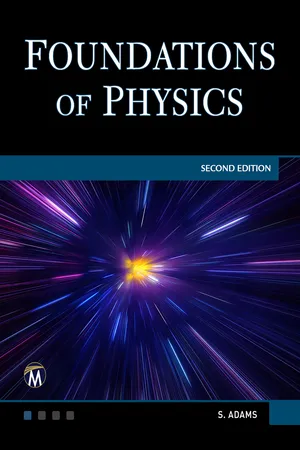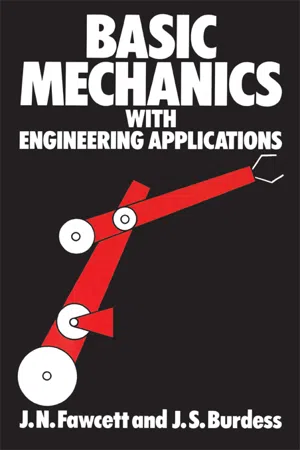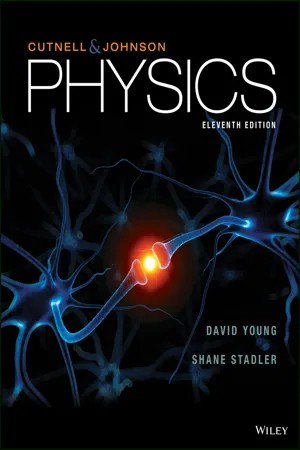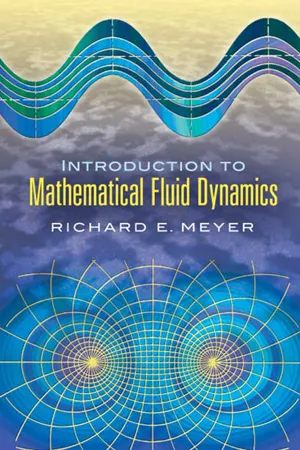Physics
Linear Momentum
Linear momentum is a fundamental concept in physics that describes the motion of an object. It is the product of an object's mass and its velocity, and it is a vector quantity, meaning it has both magnitude and direction. The principle of conservation of linear momentum states that the total linear momentum of a closed system remains constant if no external forces act on it.
Written by Perlego with AI-assistance
Related key terms
Related key terms
1 of 4
Related key terms
1 of 3
12 Key excerpts on "Linear Momentum"
- eBook - ePub
- Robert Lambourne(Author)
- 2019(Publication Date)
- CRC Press(Publisher)
However, in physics, as in life, we are often faced with situations in which predicting motion is vital, even though the relevant forces are not known in sufficient detail for Newton’s laws to be applied. Games such as snooker and pool provide an excellent example of this. When two snooker balls collide, they are in contact for a very short time during which the forces between them are rapidly varying. Predicting the outcome of such a collision using Newton’s laws would be very difficult if not impossible, yet snooker players intuitively predict the outcomes of such collisions all the time, often with astonishing accuracy. The physical quantity that makes such predictions possible is known as momentum. Loosely speaking, the momentum of a body is a measure of the difficulty of stopping that body. It is apparent that a locomotive travelling at 60 ms −1 ‘takes more stopping’ than a similar locomotive travelling at 30 m s −1. Likewise, a heavy locomotive travelling at 60 m s −1 ‘takes more stopping’ than a light locomotive travelling at that speed. The importance of the physical quantity that combines the mass and velocity of a body was perceived in the fifteenth and sixteenth centuries, and the concept was developed mathematically by Galileo and others in the seventeenth century. Newton called it the ‘quantity of motion’ of the body, but is now called Linear Momentum and is defined as follows: The Linear Momentum of a body of mass m whose centre of mass is moving with velocity υ is p = m v. (3.1) For the rest of this chapter, the word ‘linear’ will be dropped and we will simply refer to the ‘ momentum ’ of a body. In Chapter 4, however, you will see that bodies can also possess angular momentum, and you must not confuse the two. Now mass is a positive scalar quantity, and velocity is a vector quantity that can be specified in three dimensions in terms of its components υ = (υ x, υ y, υ z) - eBook - ePub
- Steve Adams(Author)
- 2023(Publication Date)
- Mercury Learning and Information(Publisher)
all forces arise as a result of interactions so the argument above will apply many times over for a complex system of interacting bodies, as long as we include all the pairs of forces. This can be stated as a law:The Law of Conservation of Linear Momentum The Linear Momentum of a closed system is constant. CommentsA “closed system” means that we include all pairs of forces within the system. Another way of saying this is that the Linear Momentum of a system is constant if no external resultant force acts on the system.Linear Momentum is a vector quantity, so the conservation of Linear Momentum implies a separate conservation of each component of Linear Momentum.An object moving along a curved path has a continuously changing momentum (it is changing direction even if its magnitude is constant).To solve problems involving the conservation of momentum it is useful to consider the total momentum of the objects before and after they interact and then to equate them. Here is a simple one-dimensional example from nuclear physics.Alpha decay: an unstable nucleus of mass M is initially at rest and decays by emitting an alpha particle (this consists of 2 neutrons and 2 protons) of mass m . The new nucleus recoils with velocity u . What is the velocity, υ , of the emitted alpha particle?Taking velocities to the right to be positive:Momentum before = 0Momentum after = mυ - MuTherefore mυ - Mu = 0 andIn alpha decay, the new nucleus is usually much more massive than the alpha particle so the alpha particle has a much larger velocity and takes away most of the energy released in the decay (kinetic energy is proportional to velocity-squared).Here is an example of a two-dimensional collision between two balls of masses m 1 and m 2 .The x - and y -components of momentum must be conserved independently of one another:x -momentum before = m 1 u + 0 = m 1 ux -momentum after - eBook - ePub
- A. L. Stanford, J. M. Tanner(Authors)
- 2014(Publication Date)
- Academic Press(Publisher)
v .Like energy, Linear Momentum is an important physical quantity because we can associate a conservation principle with it. Unlike energy, momentum has units that are not given a special name in either system of units. Therefore, the units of momentum are kg·m/s and slug·ft/s.In order to consider the conservation principle associated with momentum, let us reconsider Newton’s second law, ∑F = m a , in which m may be the mass of a single particle. In light of our discussion of center of mass, we may let M represent the mass of a system of particles in which the center of mass has acceleration a cm and write ∑F = M a cm . In either case, ∑F is the net external force acting on the particle or on the system. Let us now define the momentum P of a system of particles to be the vector sum of the momenta p of the individual particles within the system. From Equation (6-10) , the momentum P of the system is given byP = M(6-16)vc m(6-16)Then we may state the second law in terms of Linear Momentum for a particle of mass m or a system of mass M :(6-17)∑ F= m a = mdv=d t=d(m v)d tdpd t(6-17)(6-18)∑ F= Ma= Mc m=dvc md t=d(M)vc md tdPd t(6-18)In both Equations (6-17) and (6-18) - No longer available |Learn more
- Robert A. Pelcovits, Joshua Farkas(Authors)
- 2023(Publication Date)
- Barrons Educational Services(Publisher)
5Linear Momentum and Center of Mass
Learning Objectives
In this chapter, you will learn:Definition of Linear MomentumNewton’s second law in terms of momentum; impulseConservation of momentum in the absence of a net external forceElastic and inelastic collisionsCenter of massMotion of the center of massMomentum
Linear Momentum is a vector parallel to velocity. Momentum obeys superposition such that the net momentum of a collection of objects is the vector sum of the momentum of each object.The Relationship Between Force and Momentum
Thus, when the net force on an object or system of objects is zero, the net momentum remains constant (it is conserved). Recall from Chapter 3 that internal forces cannot contribute to the net force because they always cancel each other out. (This is a direct consequence of Newton’s third law: Any internal force produces an equal and opposite internal force that cancels it.) Therefore, in the absence of a net external force (Fnet = 0), the total momentum of a body or system of bodies is conserved (even if mechanical energy is not conserved). Mathematically,TIP If the net external force on a system of objects is zero, then the total momentum is conserved.Impulse is defined as follows.If the force is constant, we can put it in front of the integral sign:The Relationship Among Impulse, Force, and Time (Impulse-Momentum Theorem)
Recall from above that Therefore,Relationship between impulse and force: the impulse-momentum theoremOf course, this vector equation can also be written as a set of scalar equations:The Relationship Between Impulse and the Average Force
Applying the calculus formula to calculate the average value of a function,The graphical significance of impulse and average force is shown in Figure 5.1 . The equation tells us that the impulse is the area under the F(t) graph. The average force is this area divided by Δt, which equals the height of a rectangle of width Δt that contains the same area as the integral - eBook - ePub
Introductory Physics
Summaries, Examples, and Practice Problems
- Michael Antosh(Author)
- 2023(Publication Date)
- CRC Press(Publisher)
Linear Momentum and CollisionsDOI: 10.1201/9781003005049-77.1 Introduction: Collisions and Momentum
Collisions happen often, whether it is a charging foul in basketball, two people literally bumping into each other, or two bumper cars bumping into each other. Chapter 6 talked about the idea that the amount of something can stay the same during a certain event – this is called a conservation law. In Chapter 6 it was mechanical energy that stayed the same. For collisions, a quantity called Linear Momentum stays the same.7.2 Linear Momentum
Linear Momentum is equal to mass times velocity. It is represented by the letter p:p = m∙v(7.2.1)(p is the magnitude of momentum, m is mass, v is the magnitude of velocity) Linear Momentum is a vector. This means:- In one dimensional problems (with motion in a straight line), you need to have one direction be positive for the velocity, and one direction be negative. This is just like the problems done in Chapter 2 , with acceleration, velocity, and displacement.
- When we do two-dimensional collisions later in the chapter, we’ll use an equation for each of the x and y components. It might help to think of it as px = m∙vx and py = m∙vy
7.3 Linear Momentum Problems Without Collisions
Two problem types involve Linear Momentum but don’t involve collisions:- Calculate the amount of Linear Momentum. For these problems, just use p = m∙v (Equation 7.2.1). If the direction is requested, the direction of momentum is the same direction as the velocity.
- Calculate the change in Linear Momentum, between an initial and final time point. Here, you use Equation 7.2.1 twice – once at the final time point and once at the initial time point. As with many “change” questions, you take the (final amount) – (initial amount). If the problem is one-dimensional, the equation would be:
- eBook - ePub
- J Jones, J Burdess, J Fawcett(Authors)
- 2012(Publication Date)
- Routledge(Publisher)
6Impulse and momentumBasic Theory6.1 Linear MomentumParticleLet us suppose that the absolute velocity of the particle P shown in Fig. 6.1 is ν. If the particle has mass m then the vector quantity defined byis called the Linear Momentum of the particle. We can see from this definition that the Linear Momentum vector is in the direction of ν and has a magnitude equal to mv.FIG . 6.1If p is now resolved into components px , py along the reference directions OX and OY thenMoreover, if p is differentiated with respect to time we obtaini.e. the rate of change of the Linear Momentum of the particle is proportional to its acceleration a. We know from Newton’s Second Law of Motion that an external force, F = ma must be applied to the particle in order to produce this acceleration.When there is no external force applied, F = dp/dt = 0, which shows that the Linear Momentum of the particle is constant during the motion. This represents another way of saying that when no forces act on the particle it continues to move with uniform velocity in a straight line.Impulse of a forceLet us now consider the force F which is applied to the particle and obtain the integral of F over a time interval from t1 to t2 , so thatThe vector quantity is called the impulse of the force. By substituting eqn (6.3) into eqn (6.4) and integrating we obtainThis vector relationship is presented graphically in Fig. 6.2 which shows the change in the Linear Momentum, Δp = p2 − p1 of the particle. This is equal to the applied impulse .FIG . 6.2Example 6.1 Figure 6.3 shows two blocks, assumed to be particles, resting on a frictionless horizontal surface. Particle P1 is moving with velocity ν0 and collides with the stationary particle P2 . Let us determine the subsequent motion of the particles. We shall assume that the impact is perfectly elastic and that no energy is lost during the impact.FIG - eBook - ePub
Doing Physics with Scientific Notebook
A Problem Solving Approach
- Joseph Gallant(Author)
- 2012(Publication Date)
- Wiley(Publisher)
Chapter 6Conservation Laws
Conservation Laws are fundamentally important in physics. We say a quantity is “conserved” when its total amount never changes. Its initial value equals its final value equals its value at all times in between. In this chapter you’ll meet two of the most important conserved quantities, Energy and Momentum.Conservation laws are also powerful problem-solving tools. Even though they are consequences of Newton’s Laws, the approach to using them is different than the cause-and-effect methods of the last chapter. When we used Newton’s 2nd Law, we applied it to each object separately. When we use a conservation law, we’ll look at the system as a whole, not at the individual parts, and keep track of the total amount of the conserved quantity. Still, our goal is the same: to understand and explain changes in motion.Definitions
To understand and explain changes in motion, we need to consider both velocity and mass. Stopping a train moving at 5 mi/h is not the same as stopping an empty shopping cart moving at 5 mi/h. They have the same speed, but not the same mass. Catching a baseball moving at 5 mi/h is not the same as catching one moving at 100 mi/h. They have the same mass, but not the same speed.We can define a new vector called momentum as the product of mass times velocity. This is such a useful and important concept that when Newton used the word “motion” in the Principia, he often meant what we today call momentum.(6.1)The magnitude of the momentum is p = mv and its direction is the same as the velocity vector. The metric unit of momentum is the kg m/s.Calculate the momentum of a 1500 kg car moving at a speed of 15 mi/h. Do the same for a baseball moving at a speed of 80 mi/h. Which has more momentum?Example 6.1Some typical valuesSolution.Use Eq. (6.1) to create an expression for the car’s momentum using the given values. Select the car’s velocity and apply Evaluate Numerically in-place to convert it to meters per second, then Evaluate - eBook - ePub
- John D. Cutnell, Kenneth W. Johnson, David Young, Shane Stadler(Authors)
- 2018(Publication Date)
- Wiley(Publisher)
An isolated system is one for which the vector sum of the external forces acting on the system is zero. The principle of conservation of Linear Momentum states that the total Linear Momentum of an isolated system remains constant. For a two-body system, the conservation of Linear Momentum can be written as in Equation 7.7b, where m 1 and m 2 are the masses, v → f 1 and v → f 2 are the final velocities, and v → 01 and v → 02 are the initial velocities of the objects. (7.7b) m 1 v → f 1 + m 2 v → f 2 ⏟ Final total Linear Momentum = m 1 v → 01 + m 2 v → 02 ⏟ Initial total Linear Momentum 7.3 Collisions in One Dimension An elastic collision is one in which the total kinetic energy of the system after the collision is equal to the total kinetic energy of the system before the collision. An inelastic collision is one in which the total kinetic energy of the system is not the same before and after the collision. If the objects stick together after the collision, the collision is said to be completely inelastic. 7.4 Collisions in Two Dimensions When the total Linear Momentum is conserved in a two-dimensional collision, the x and y components of the total Linear Momentum are conserved separately. For a collision between two objects, the conservation of total Linear Momentum can be written as in Equations 7.9a and 7.9b. (7.9a) m 1 v f 1 x + m 2 v f 2 x ⏟ x component of final total Linear Momentum = m 1 v 01 x + m 2 v 02 x ⏟ x component of initial total Linear Momentum (7.9b) m 1 v f 1 y + m 2 v f 2 y ⏟ y component of final total Linear Momentum = m 1 v 01 y + m 2 v 02 y ⏟ y component of. initial total Linear Momentum 7.5 Center of Mass The location of the center of mass of two particles lying on the x axis is given by Equation 7.10, where m 1 and m 2 are the masses of the particles and x 1 and x 2 are their positions relative to the coordinate origin. If the particles move with velocities v 1 and v 2, the velocity v cm of the center of mass is given by Equation 7.11 - Paul Grimshaw, Neil Fowler, Adrian Lees, Adrian Burden(Authors)
- 2007(Publication Date)
- Routledge(Publisher)
Fig. B4.2.Momentum before collision = Momentum after collision(0.5 × 15) + (75 × 0) = (75.5 × 0.1)7.5 + 0 kg.m/s = 7.5 kg.m/sAgain, it is important to note that this is horizontal Linear Momentum that we have determined. In addition, it is also possible to see that if we did not already know the velocity for the ball and the goalkeeper after collision we could use this equation to calculate the combined velocity.Application
It is important to remember that Linear Momentum possessed by a system will remain constant in both magnitude and direction, and that the principle of conservation of Linear Momentum is valid only if the following conditions are met:1. There is no external impulse (since as we have seen impulse = force × time and it is related to a change in momentum) in other words, no external force. 2. The total mass of the system (bodies that are colliding) remains constant.To illustrate this principle in a more simplified form (i.e., not involving human bodies or projectile objects such as soccer balls),Fig. B4.3identifies a more practical example.ConsideringFig. B4.3, we can see that ball A has a mass of 2 kg and is moving towards ball B with a horizontal velocity of 8 m/s. Ball B is also moving in the same direction away from ball A but with a velocity (horizontal) of 2 m/s. Ball B has a mass of 1 kg.As the balls collide, there will be an impulse exerted by one ball on the other (i.e., a force applied for a period of time). In this case the contact time is expected to be small and therefore it is likely that the force will be high. There will be a change in momentum brought about by the impulse but the total amount of momentum (before and after collision) will remain constant. Ball A will experience an impulse in the direction from RIGHT to LEFT (as it will experience a force from ball B (the action–reaction law)) whereas ball B will experience an impulse in the direction from LEFT to RIGHT because it is ball A that is making the contact (the action). The two balls (A and B) will experience a change in momentum that is equal to the amount of impulse that is created and this change in momentum as we have seen is dependent upon the force and the amount of time that it is applied for. Similarly, we have seen that momentum is related to mass and velocity and in the case of the ball with more mass (2 kg) there will be less change in velocity for a given momentum. Similarly, for the ball with a smaller mass (1 kg) there would be a greater change in velocity in a given direction. It is important to point out that this change in momentum (or velocity in each case since the mass is constant) will take place in the direction of the impulse (the applied force). For example, for ball A there will be a change in momentum in the direction from RIGHT to LEFT whereas for ball B there will be a change in momentum in the direction from LEFT to RIGHT. Again, it is important to reiterate that we are referring to horizontal Linear Momentum- eBook - ePub
- Benjamin Crowell(Author)
- 2018(Publication Date)
- Studium Publishing(Publisher)
Accounting works because money is conserved. Apparently, something is also conserved when the balls collide. We call it momentum. Momentum is not the same as velocity, because conserved quantities have to be additive. Our pool balls are like identical atoms, but atoms can be stuck together to form molecules, people, and planets. Because conservation laws work by addition, two atoms stuck together and moving at a certain velocity must have double the momentum that a single atom would have had. We therefore define momentum as velocity multiplied by mass.This is our second example of Noether’s theorem:Conservation of momentumThe quantity defined by momentum = mv is conserved.symmetry conserved quantity time translation ⇒ mass-energyspace translation ⇒ momentum Conservation of momentum for pool ballsexample 4‣ We have to check whether the total initial momentum is the same as the total final momentum. dark ball’s initial momentum + light ball’s initial momentum =? dark ball’s final momentum + light ball’s final momentum Yes, momentum was conserved:‣ Is momentum conserved in figure g/1?0 + mv = mv + 0h / example 5Figure skaters push off from each otherexample 5left skater’s initial momentum + right skater’s initial momentum =? left skater’s final momentum + right skater’s final momentum Momentum was conserved:Let’s revisit the figure skaters from the example on page 11. I argued there that if they had equal masses, then mirror symmetry would imply that they moved off with equal speeds in opposite directions. Let’s check that this is consistent with conservation of momentum:0 + 0 = m × (−v) + mvThis is an interesting example, because if these had been pool balls instead of people, we would have accused them of violating conservation of energy. Initially there was zero kinetic energy, and at the end there wasn’t zero. (Note that the energies at the end don’t cancel, because kinetic energy is always positive, regardless of direction.) The mystery is resolved because they’re people, not pool balls. They both ate food, and they therefore have chemical energy inside their bodies: - eBook - ePub
Newtonian Dynamics
An Introduction
- Richard Fitzpatrick(Author)
- 2021(Publication Date)
- CRC Press(Publisher)
This is particularly the case if the internal forces, f 12 and f 21, are complicated in nature. Suppose that there are no external forces acting on the system (i.e., F 1 = F 2 = 0), or, equivalently, suppose that the sum of all the external forces is zero (i.e., F = F 1 + F 2 = 0). In this case, according to Equation (6.6), the motion of the center of mass is governed by Newton’s first law of motion; that is, it consists of uniform motion in a straight-line. Hence, in the absence of a net external force, the motion of the center of mass is almost certainly far simpler than that of the component masses. The velocity of the center of mass is written v c m ≡ x ˙ c m = m 1 x ˙ 1 + m 2 x ˙ 2 m 1 + m 2. (6.7) We have seen that in the absence of external forces v c m is a constant of the motion (i.e., the center of mass does not accelerate). It follows that, in this case, m 1 x ˙ 1 + m 2 x ˙ 2 = constant, (6.8) is also a constant of the motion. Recall, however, from Section 4.3, that momentum is defined as the product of mass and velocity. Hence, the momentum of the first mass is written p 1 = m 1 x ˙ 1, whereas the momentum of the second mass takes the form p 2 = m 2 x ˙ 2. It follows that the previous expression corresponds to the total momentum of the system. In other words, P = p 1 + p 2 = constant. (6.9) Thus, the total momentum is a conserved quantity; provided there is no net external force acting on the system. This is true irrespective of the nature of the internal forces. More generally, Equation (6.6) can be written d P d t = F. (6.10) In other words, the time derivative of the total momentum is equal to the net external force acting on the system; this is just Newton’s second law of motion applied to the system as a whole. 6.2.1 Hot-Air Balloon Let us now apply some of the concepts discussed previously to an example physical system. Consider the simple two-component system shown in Figure 6.2 - eBook - ePub
- Richard E. Meyer(Author)
- 2012(Publication Date)
- Dover Publications(Publisher)
CHAPTER 2Momentum Principle and Ideal Fluid
10. Conservation of Linear Momentum
Postulate VI (Momentum Principle). A vector field f and a tensor field with components p if are defined on the closure of any fluid domain Ωt with regular boundary surface ∂Ωt so that(10.1)where n is the unit outward normal on ∂Ωt .The left-hand side of (10.1) represents the rate of change of the Linear Momentum of the body of fluid which occupies the domain Ωt , and the right-hand side therefore represents the resultant external force exerted on this body of fluid. The postulate states that external force can be exerted on the fluid in two ways: by a stress acting on the surface of the fluid and by a body force ρ f acting directly on each volume element. The most common body forces are gravity, centrifugal and Coriolis forces (to be considered only in Chapter 5), and electromagnetic forces (not considered in this book). Since the postulate applies also to every subdomain of a fluid domain, p ij n j represents the i -component of force per unit area exerted across an area element with “outward” unit normal n by the fluid on the “outer” side of the area element upon the fluid on its “inner” side.It should be emphasized that this postulate is more fundamental than those of Sections 1 and 2, in the sense that Postulates V, VI, and VIII (in contrast to Postulates I to IV) hold for all of continuum mechanics.It may also be noted that the momentum principle does not require the pointwise definition of f i and p ij . Indeed, the values of these quantities (and of the density) at a point are not directly observable, and only the integrals occurring in Postulates V and VI have strict physical meaning. As noted in Section 3, however, ρ and p ij
Index pages curate the most relevant extracts from our library of academic textbooks. They’ve been created using an in-house natural language model (NLM), each adding context and meaning to key research topics.
Explore more topic indexes
Explore more topic indexes
1 of 6
Explore more topic indexes
1 of 4











